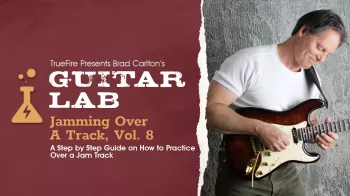
“5150” is the seventh studio album by Van Halen, released in 1986. The album marked a significant change in the band’s lineup, with Sammy Hagar replacing David Lee Roth as the lead singer. The album not only exceeded expectations, but gave them their first Billboard 200 number one spot. In this licklibrary guitar course, Sam Bell returns with another journey through the guitar parts from a Van Halen classic album, teaching you how to reproduce Eddie Van Halen’s riffs and guitar solos. From fiery fills and acrobatic leads to a meeting of simple crunching riffs paired with rhythm guitar virtuosity; this Classic Album course has something for every rock guitarist.
This article delves into the intricacies of each song and highlights the contributions of guitarists Eddie Van Halen and Sammy Hagar, as well as the techniques and scales used throughout the album.
Track 1: Good Enough
“Good Enough” starts the album with a bang, featuring a powerful riff in the E Mixolydian scale. The song is characterised by its galloping rhythms, power chords, and a driving tempo. The guitar solo, showcasing Eddie’s signature tapped harmonics and alternate picking, is a testament to his virtuosity.
Track 2: Why Can’t This Be Love
In this synth-driven track, the guitar parts are relatively subdued but still exhibit Eddie’s unique style. The guitar solo is played in the E minor scale, and the legato phrasing adds a fluid feel to the melody. The song also features barre chords and octave melodies, providing a solid foundation for Hagar’s powerful vocals.
Track 3: Get Up
“Get Up” is a high-energy track that showcases Eddie’s incredible speed and precision. The song employs the E Phrygian Dominant scale, and the guitar riff is heavily influenced by syncopated rhythms. The solo features a combination of two-handed tapping, hammer-ons, and pull-offs, creating a mesmerising cascade of notes.
Track 4: Dreams
“Dreams” is another synth-heavy track with an uplifting melody. The guitar work is more subtle in this song, but Eddie’s contribution is still evident. He employs arpeggiated chord progressions and sweep picking during the intro, creating a rich harmonic landscape. The guitar solo, played in the G major scale, features string bending, slides, and vibrato, adding an emotional depth to the song.
Track 5: Summer Nights
“Summer Nights” is a feel-good track that highlights Eddie’s innovative playing style. The intro features a creative use of open-string riffs and altered tunings, giving the song a distinct, open sound. The main riff is built around the E major scale and incorporates palm muting to create a tight, rhythmic groove. During the guitar solo, Eddie makes use of whammy bar tricks and pinched harmonics to add excitement and character.
Track 6: Best of Both Worlds
“Best of Both Worlds” is a catchy, upbeat track that features a memorable riff in the G Mixolydian scale. The rhythm guitar parts employ power chords and chord progressions to provide a solid foundation for Hagar’s soaring vocals. The guitar solo showcases Eddie’s impeccable technique, including alternate picking, double-stops, and trills.
Track 7: Love Walks In
“Love Walks In” is a beautiful ballad that highlights the band’s softer side. The song is built around the D major scale, and the guitar parts are characterised by arpeggios and clean chord progressions. Eddie’s solo, played with a clean tone, employs legato techniques and slides to create a smooth, flowing sound.
Track 8: 5150
The title track, “5150,” is a hard-rocking song with a driving rhythm and an infectious main riff in the A Dorian scale. The guitar work is characterised by power chords, palm muting, and syncopated rhythms. Eddie’s solo is a masterclass in technical prowess, featuring two-handed tapping, hammer-ons, and pull-offs, along with dive bombs for added impact.
Track 9: Inside
“Inside” is a funky, experimental track that showcases the band’s versatility. The main riff is based on the E Mixolydian scale, and the rhythm guitar parts are built around funky chord progressions and syncopated rhythms. Eddie employs various techniques, such as finger-picking, hybrid picking, and slap guitar to create a unique texture. The guitar solo features double-stop bends, unison bends, and chromaticism, showcasing Eddie’s ability to adapt his style to suit the song’s unconventional feel.




![Puremix Start To Finish Jacquire King Flux Keep The Light On EP 10-25 [TUTORiAL]](http://www.bixinyinyuan.com/wp-content/uploads/2025/02/1739327625487.png)
